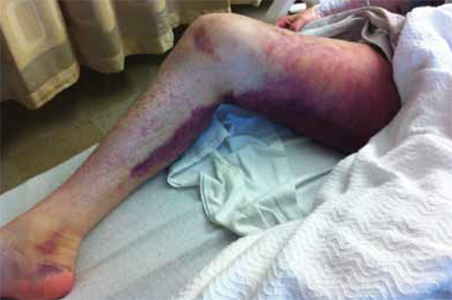A Good-quality patient-oriented evidence
B Inconsistent or limited-quality patient-oriented evidence
C Consensus, usual practice, opinion, disease-oriented evidence, case series
A 31-YEAR-OLD MAN with a history of depression, alcohol abuse, and rosacea sought care at our clinic for worsening light-headedness, rash, and bruising. Two weeks earlier, he had been to the emergency department (ED) for a syncopal event. The work-up at that time included:
- electrocardiogram showing sinus tachycardia
- lower extremity duplex ultrasound that was negative for deep vein thrombosis or fluid collection
- computed tomography angiogram of the chest that was negative for pulmonary embolus
- lab work that showed normal platelets and international normalized ratio.
The patient did, however, have a notable decrease in hemoglobin from a baseline of 15 g/dL to 12 g/dL, low serum albumin, and mildly elevated aspartate aminotransferase (AST) and total bilirubin.
The patient received 3 liters of intravenous normal saline and was discharged home to follow up as an outpatient. During his visit to our clinic, we noted an extensive purpuric rash on the posterior aspect of his thighs, although his right thigh was worse than his left (FIGURE 1). The patient also had a diffuse follicular petechial rash on his legs. The circumference of his right thigh was 61 cm and his left thigh was 51.5 cm.
FIGURE 1
Diffuse ecchymosis on the right thigh

Repeat labs in the clinic showed a further decrease in hemoglobin to 9.2 g/dL. The patient was advised to go to the ED, where a work-up revealed that he had normocytic-normochromic anemia; his hemoglobin was 8.9 g/dL. Liver function tests revealed elevated AST and alanine aminotransferase (AST:ALT=3.66).
The patient was admitted to the family medicine inpatient service, where his hemoglobin continued to decline. He received a total of 4 units of packed red blood cells.
WHAT IS YOUR DIAGNOSIS?
HOW WOULD YOU TREAT THIS PATIENT?

